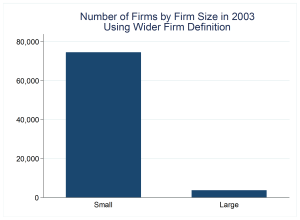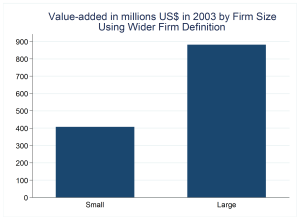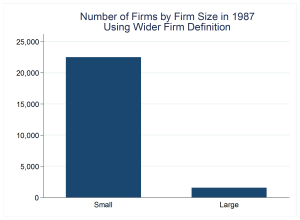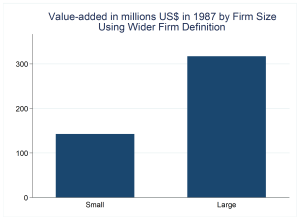Is small beautiful when it comes to firms in poor countries? Whatever one thinks is the answer to that question the pervasiveness of small scale enterprises in countries in sub-Saharan Africa is not in dispute. In a recent CSAE discussion paper, I document that in Ghana not only do small firms dominate the urban industrial landscape but this dominance has been increasing over the period from 1987 to 2003. It thus rather matters if we think this is progress in moving people out of poverty or signs of increasing immiserisation – a rather more prosaic question than the beauty of the small but nonetheless a vitally important question for policy in developing countries.
Newly available data from the Ghana Statistical Office has enabled the pattern of small firm growth to be seen in a longer term perspective and the data is relevant for several issues which have been prominent in discussions of policy in Africa. The reforms in the late 1980s and early 1990s in moving African economies towards more market oriented policies, often under instructions from the IMF, were deeply contentious. How did small firms perform under the new regime relative to the old one and how much did employment in them increase? Small firms are traditionally viewed as part of the informal sector and an influential policy agenda set out by the ILO argues for a focus on ‘decent jobs’. Are the jobs that were created between 1987 and 2003 in Ghana’s manufacturing sector ‘decent’ ones? Finally how successful were these small firms in producing value-added, which is after all what firms are there to do?
Well the answer to the first of these questions is crystal clear. Between 1962 and 1987, roughly the period of the old market hostile regime, the number of small manufacturing firms in urban Ghana scarcely changed. Between 1987 and 2003 their number more than tripled as did employment in them. IMF type policies are good for small firms or, at the very least, do them no harm. And yes small firms created lots of jobs over this period. Data from the household surveys for the period from 1998 to 2005 show that employment in small firms (across all sectors, not simply manufacturing) rose from 3.4 per cent of the population aged 15-65 to 6.7 per cent, an employment rise from 352,401 to 885,391.
But, and it’s an important qualification, these jobs are badly paid relative to those working in larger firms where employment in manufacturing actually fell. So were these ‘bad’ jobs that have been created, ones which the ILO wishes to disappear? Certainly, their report is explicit that a contraction of the informal sector is necessary to promote their agenda However, a rather more relevant question for the poor is – did those working there see an increase in their incomes? Again the answer from the household surveys seems clear. Yes and these income gains were substantial. Between 1998 and 2005 men’s incomes rose in real terms by 45 per cent and women’s by 51 per cent. Poorly paid the jobs were, the key point is that they were becoming better paid.
It is the role of small firms in the development process which is more complex. The Ghana data certainly suggest that their formation is not a problem. But their productivity measured as value-added per employee is low relative to larger firms. Even more important their relative productivity seems to have fallen over the period from 1987 to 2003.
So is small beautiful? The answer appears to be that small firms are good at what small firms do. They create lots of jobs using little capital when policy lets them – in Ghana after 1987 but not before. But large firms are valuable too, they have far more capital per employee and produce far more output – the figure graphically illustrates that while small firm dominate in numbers they produce far less value-added than large ones. So much so that in 2003 the top 1 per cent of firms produced 63 per cent of value-added. Policy rhetoric focuses on the problems faced by small firms. Data from Ghana over the period for which we have it suggests that it is large firms that face the problems. Unloved possibly because they are not seen as beautiful they are vital for the output of the sector. Policy, not for the first time in Africa, seems to be focused on completely the wrong problem.
| Figure of the number of manufacturing firms and the total value-added for 1987 and 2003 in urban Ghana. | |
 |
 |
| Note: A small firm employs less than 10, a large firm 10 or more. | |



The issue doesn’t seem to be that more focus should be on big business. There is quite a bit of research that small businesses never grow to be big business in Africa. The “missing middle” from my own research and experience seems to be where the focus needs to be but seldom is.